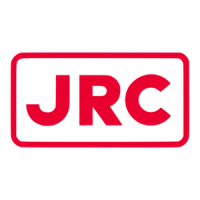
Do you have a question about the JRC JMA-5212-4 and is the answer not in the manual?
| Brand | JRC |
|---|---|
| Model | JMA-5212-4 |
| Category | Marine Radar |
| Language | English |
Explains symbols used in the manual and on equipment for safety.
Informs about the presence and prohibition of removing the warning label on the equipment.
Details critical warnings related to electrical hazards and antenna safety.
Shows the locations of warning labels on the Radar Process Unit and LCD Monitor.
Displays images and types of various scanner units.
Displays images of the Processor Unit and LCD Monitor.
Lists interconnection diagrams for various system components.
Provides definitions for technical terms used in the manual, categorized alphabetically.
Describes the primary functions and capabilities of the radar system.
Highlights the main features and technological advancements of the radar system.
Details the hardware configuration, including scanners and radar systems.
Provides exterior drawings and dimensions for various system components.
Illustrates the system's interconnections and block diagrams for main components.
Shows a sample radar display, illustrating the layout and information presented.
Identifies and explains the function of each key on the radar's control panel.
Details the functions of the software buttons displayed on the radar screen.
Outlines the fundamental procedure for powering on and starting the radar system.
Explains the hierarchical structure of the radar's menu system for accessing functions.
Covers initial setup, including display brilliance and contrast adjustments.
Explains fundamental operations such as starting transmission and adjusting range.
Details general operations including cursor movement, EBLs, and VRMs.
Explains how to use the cursor and trackball for measuring target range and bearing.
Describes how to use range rings for distance measurement on the radar display.
Details the use of Electronic Bearing Lines (EBLs) and Variable Range Markers (VRMs) for measurements.
Explains how to measure the range and bearing between two selected points on the display.
Covers initial setup and features of Target Tracking (TT) and AIS functions.
Explains how to use the Target Tracking (TT) functions for acquiring and tracking targets.
Details the operation and settings for the Automatic Identification System (AIS).
Describes how to configure the association settings for TT and AIS targets.
Lists and explains the various alarm messages for TT and AIS functions.
Explains the concept of radar wave propagation and its relation to the horizon.
Discusses factors affecting target echo intensity and radar detection distance.
Explains sea, rain, and snow clutter and how to mitigate them using rejection functions.
Details common causes of false echoes like shadow, side lobe, and multiple reflections.
Covers electrical adjustment procedures for system installation by authorized personnel.
Explains settings for integrating navigation equipment like gyro and GPS.
Details communication port, language, and date/time display settings.
Describes procedures for adjusting system parameters like noise level and target tracking.
Covers maintenance tasks including safety switch settings and memory initialization.
Provides essential guidelines for routine cleaning and general equipment care.
Outlines maintenance procedures for individual units like the scanner and display.
Details how to perform operational checks and tests on system components.
Provides step-by-step instructions for replacing major parts like magnetron and motors.
Lists system alarms, indications, and error messages for fault identification.
Provides guidance on common troubles and potential causes like poor contact.
Explains warranty periods, repair requests, and recommended maintenance services.
Advises on following local laws and regulations for unit disposal.
Provides safety precautions and guidelines for disposing of used lithium batteries.
Instructs on the proper return procedure for used magnetrons.
Details compliance with China RoHS regulations regarding hazardous substances.
Lists the technical specifications for the JMA-5204 type radar.
Lists the technical specifications for the JMA-5208/HS type radar.
Lists the technical specifications for the JMA-5209 type radar.
Lists the technical specifications for the JMA-5212-4/6/4HS/6HS type radar.
Lists the technical specifications for the JMA-5222-7/9 type radar.
Provides detailed specifications for the NKE-2043 scanner unit.
Provides detailed specifications for the NKE-2062 scanner unit.
Provides detailed specifications for the NKE-2062HS scanner unit.
Provides detailed specifications for the NKE-2063A scanner unit.
Provides detailed specifications for the NKE-2103-4/6 scanner unit.
Provides detailed specifications for the NKE-2103-4HS/6HS scanner unit.
Provides detailed specifications for the NKE-2254-7/9 scanner unit.
Lists the specifications for the NCD-4380 Display Unit.
Lists the specifications for the NDC-1460 Processor Unit.
Details the specifications for the NCA-877A Target Tracking Unit.
Lists the specifications for the NQA-2155 AIS Unit.
Provides specifications for the Plotter Unit, including synthesis modes.
Lists the specifications and functions of the NCE-7699A Keyboard Unit.
Details the specifications for the NJU-85 Performance Monitor.
Specifies the input signals receivable from navigation equipment.
Lists the output signals that the radar system can provide.
Outlines the standard configuration of the radar system components.
Specifies recommended distances between radar components and other instruments.
Lists optional accessories and their specifications.
Lists interconnection diagrams for various system components.
Identifies the product name, model, and series for regulatory purposes.
Provides the name and address of the manufacturer, Japan Radio Co., Ltd.
Lists the specific apparatus models covered by the declaration of conformity.
States the relevant EU harmonization legislation, Radio Equipment Directive (RED).
References the harmonized standards used for conformity declaration.
Shows the compatibility of system components like display units and scanners.
Lists the software versions for various system units.
Provides additional information on antenna length, peak power, and model numbers.
